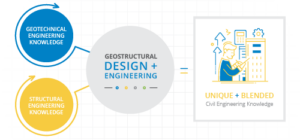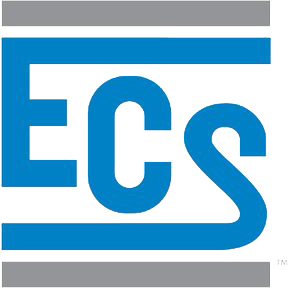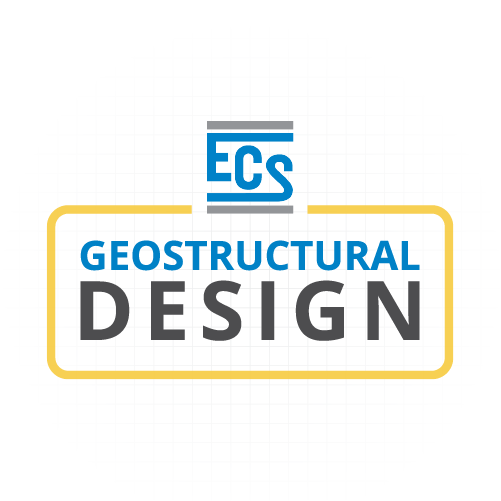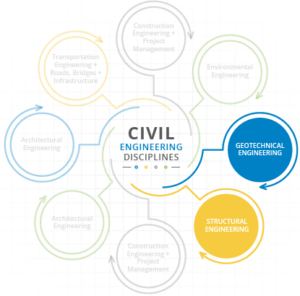Geostructural design is a specialized discipline combining traditional structural engineering with geotechnical expertise to examine how a structure and the earth will interact with each other. Engaging with a geostructural designer early in a project can prevent errors before they occur, mitigate construction risks and identify adequate constructibility. When applied effectively, the resulting design is efficient, long-lasting and sturdy.
THE INTERSECTION OF GEOTECHNICAL AND STRUCTURAL ENGINEERING
|
Geotechnical and structural engineers are both civil engineers, yet they have specialties that define their areas of expertise. Despite this, of all civil engineer types, geotechnical and structural engineers are the most similar because they both perform stability, stress and strain calculations for structures. Geotechnical engineers rely on subsurface characterization to determine the engineering properties of the earth materials they design for. Structural engineers create drawings and specifications, perform calculations and design structural components with known engineering properties. Combining these two professionals is the practice of geostructural engineering. |
|
|
Site retaining walls, below-grade support of excavation walls, micropile design, slope reinforcement, ground anchors and deep foundation design are examples of how geotechnical and structural engineers blend, resulting in geostructural design. The practice of geostructural design is unique and requires blended knowledge of these specialty areas of civil engineering.
WHO BENEFITS FROM GEOSTRUCTURAL DESIGN SERVICES?
Any municipality, commercial or residential builder preparing for a construction project benefits from engaging with an experienced geostructural designer to protect their investment and control costs.
While geostructural design can be conducted before, during or after a construction project, the best and most cost-effective results come from geostructural design completed before construction begins.

ECS GEOSTRUCTURAL DESIGN CASE STUDYECS completed work on a project in Prince William County, Virginia, an area known for landslide risks. The project included constructing a large parking garage and mixed-use development near the crest of the top of a slope. The slope led down to train tracks and a future train station. Conventional geotechnical slope-stability analysis indicated that the slope was not sufficiently stable to construct the garage and mixed-use development safely. To stabilize the slope adequately, ECS conducted a slope-reinforcement geostructural design that included a row of closely spaced, reinforced-concrete drilled shafts extending deep into the soil profile. The shafts were subject to shear and moment forces from the unstable slope’s movements. Determining the forces and moments on the deeply embedded shafts required a strong grasp of geotechnical engineering, and the size and reinforcing details of the drilled shafts required a similar grasp on structural engineering.
|
This is the first post in our first series about geostructural design.
Keep reading for more information.
Series 1 – Geostructural Design:
Part 2: Unique Aspects of Geostructural Design
Part 3: Why Hire a Geostructural Design Consultant
Series 2 – Contractor Delegated Design:
Part 1: What Is Contractor Delegated Design?
Part 2: Delegated Design Benefits, Risks and Pitfalls
Part 3: Bridging the Gap for Delegated Design
Series 3 – Earth Retaining Systems:
Part 1: Earth Retaining Structures: Who Designs Them… and How Do They Work?
Parts 2 + 3: Coming Soon
About the experts
Karl Higgins, PE, D.GE, earned a bachelor’s and master’s in engineering with a focus on geotechnical engineering.
Doug Chappell, PE, has a bachelor’s degree in mining engineering with experience in consulting and design-build specialty contracting.
Combined, they have more than 60 years of experience. Together, Doug and Karl lead the geostructural design practice at ECS.
Contact us to discuss your geostructural design needs.


